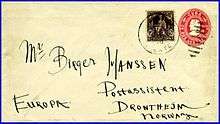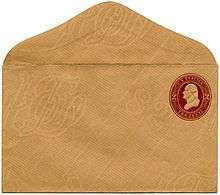Stamped envelope

A stamped envelope or postal stationery envelope (PSE) is an envelope with a printed or embossed indicium indicating the prepayment of postage. It is a form of postal stationery.
In the United Kingdom
The Sherborn Collection in the British Library Philatelic Collections is an important collection of 1841-85 Queen Victoria embossed 1d pink stamped envelopes. The collection was formed by C. Davis Sherborn and donated to the British Museum in 1913.[1]
Use in the United States

In August 1852 an act of the U.S. Congress authorized the Postmaster General to provide "suitable letter envelopes with such watermarks or other guards against counterfeits... with the addition of the value or denomination of the postage stamps so printed or impressed thereon...". The first result was the 1853 Nesbitt issues of stamped envelopes, named after the private contractor who produced them for the government.[2] When you combine the different envelope sizes, knives, colors, dies to print the indicia, and denominations there are literally thousands of different stamped envelopes produced for the U.S.[3]
Collecting
Collectors of stamped envelopes use a catalog to know what has been issued.
Siegfried Ascher was the first to try to comprehensively document all countries' postal stationery including stamped envelopes.[4] This was followed some 40 years later by the Higgins & Gage World Postal Stationery Catalog. Though now out of date, it is still frequently cited since it covers all countries and no other comprehensive catalog has been attempted since. The H&G catalog, as it is known, describes stamped envelopes by the envelope size, the depicted indicia and its valuations, some corner cards, while sometimes disregarding envelope color.
The Scott catalogue is the United States envelope color and value of the indicia which is perfect for dealing with cut squares, but falls short of information needed to collect entires, i.e. the whole envelope. The United Postal Stationery Society has two published books cataloging U.S. stamped envelopes.[2][3] These books describe all of the other stated criteria plus the envelope knife making them the most complete U.S. stamped envelope catalogs.
British postal stationery to 1970 has been comprehensively documented[5] and Edifil is a Spanish company that has comprehensive listings for stamped envelopes of Spain, Cuba, Philippines and Puerto Rico.
Most stamped envelopes are collected as entires. In the 19th century the practice was to collect cut squares (or cut-outs in the U.K.)[6] which involved cutting the embossed indicia from a postal envelope. This destroyed the envelope. As a result, one cannot tell from a cut square what specific envelope it came from and, many times, the cancellation information. The manner in which the stamped envelope is cut before folding (that is, its knife) vanishes on a cut square. The envelope size disappears, too, with a cut square.
In collecting entires, a single indicium may appear on many different sizes of envelopes. Some countries have issued the same indicium on different paper types: laid and wove. Likewise it is common for the same indicium to be embossed onto paper of several different colors. Finally, two envelopes of the same size can have a different flap size indicating that they were cut from a different knife. Rarely, an uncatalogued color, or displaced surcharge, or albino indicium, or inside-out folding of the envelope may appear, in which case you have found something of value. All of these attributes relate to mint or unused envelopes. When you add a postmark from a used envelope to the mix, the collecting possibilities explode. What was formerly in fashion, collecting only mint examples, has changed because many collectors seem to find used PSE collections more interesting.[6]

Some postal stationery envelopes contain a corner card, a printed return address on the envelope, usually in the upper left hand corner. This can range from a simple town and country notation to an elaborate illustrated advertisement for a business. Corner cards are either applied by an after-market print shop or by dealing with the government related entity that produces the stamped envelopes.
See also
References
- ↑ The Sherborn Collection. British Library, 29 January 2012.
- 1 2
- 1 2 Undersander, Dan, Ed.; Catalog of the 20th and 21st Century Stamped Envelopes and Wrappers of the United States, Third Edition, UPSS, 2011. ISBN 978-0-9800112-8-9.
- ↑ Ascher, Dr Siegfried, Grosser Ganzsachen-Katalog (1925) in German.
- ↑ Huggins, A.K. British Postal Stationery, A Priced Handbook of the Postal Stationery of Great Britain, Great Britain Philatelic Society (1970).
- 1 2 Van Gelder, Peter J.; The Collectors' Guide to Postal Stationery, A Squirrel Publication (1997) ISBN 0-947604-07-3
Further reading
- Higgins & Gage World Postal Stationery Catalog, 19 volumes covering the whole world. Out of print, but worth looking for.
- Huggins, A.K.; British Postal Stationery, A Priced Handbook of the Postal Stationery of Great Britain, Great Britain Philatelic Society, 1970
- Thorp-Bartels Catalogue of U.S. Stamped Envelopes, Century Edition, 1954
- Cutting Knife Handbook by United Postal Stationery Society, 1999. Envelope knives illustrated.
| Wikimedia Commons has media related to Stamped envelope. |